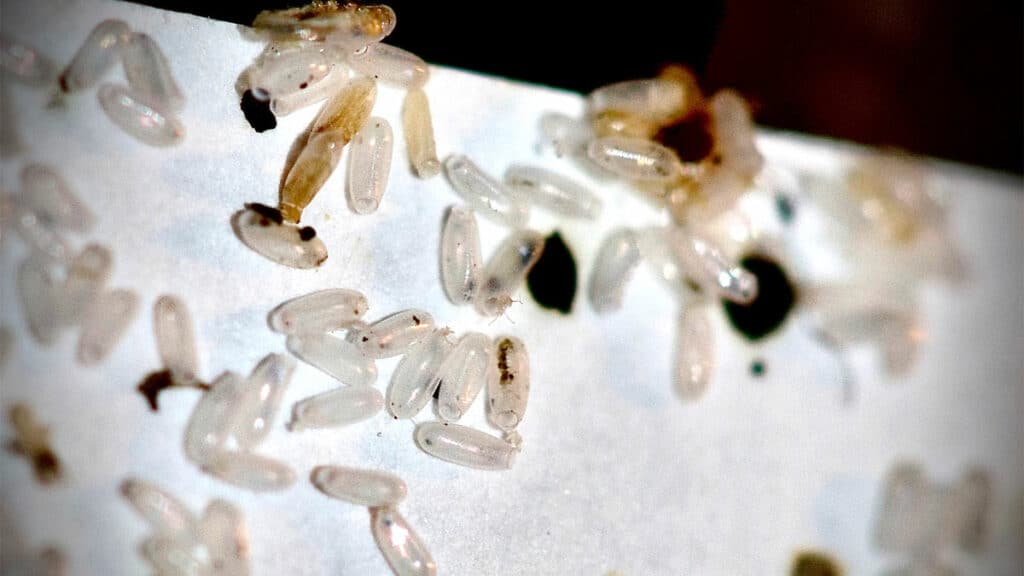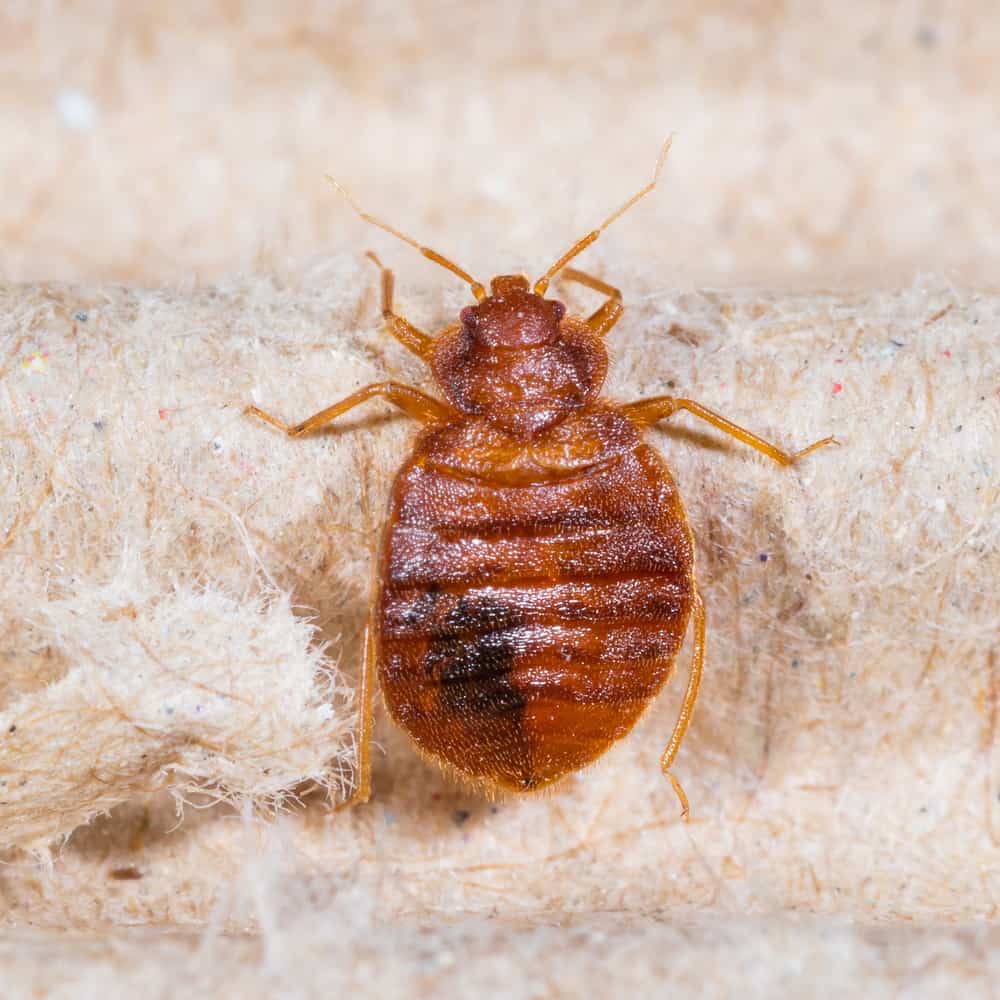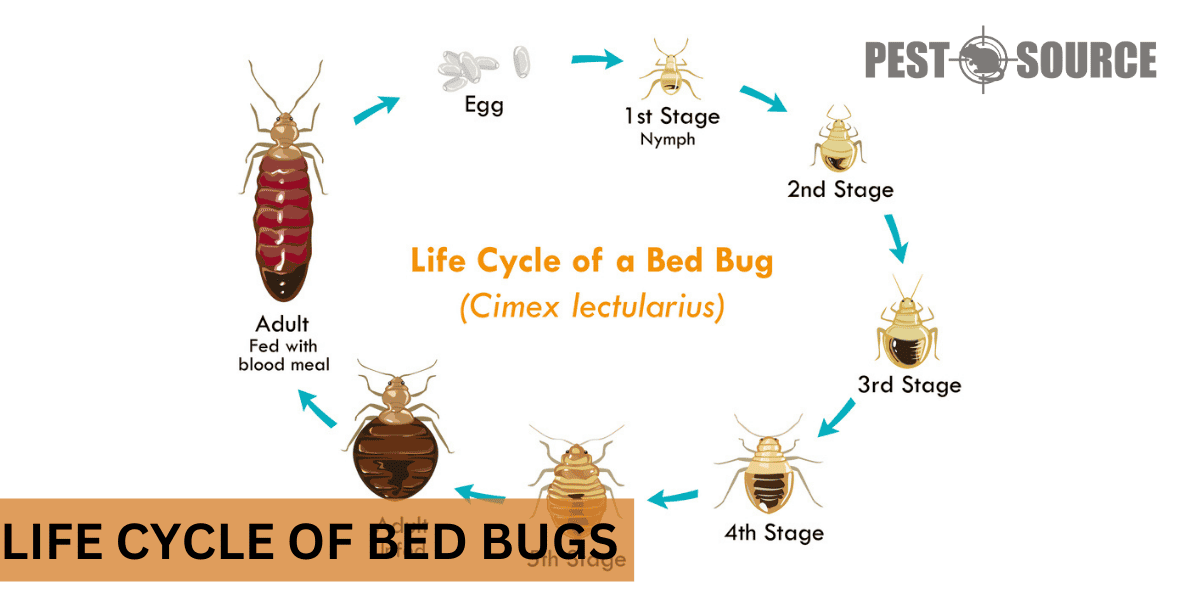Bed bugs undergo a life cycle that includes five nymph stages before reaching adulthood, each requiring a blood meal to progress. This cycle, from egg to adult, typically spans about one month, influenced by temperature and availability of food. Understanding these stages is crucial for effective eradication, as each stage requires a different approach, a key aspect this post will explore in detail.
POINTS
- Bed bugs have a life cycle that consists of seven stages—from the egg to five nymphal or ‘instar’ stages, and finally the adult form. Understanding each stage can provide insight into the pest’s survival strategies and aid in implementing effective control measures.
- Female adult bed bugs can lay 1 to 5 eggs each day, and up to 500 in their lifetime. Each egg hatches into a nymph that grows through each life stage by consuming a blood meal and molting.
- Nymphs undergo five instar stages, increasing in size with each molting. Adult bed bugs are approximately 5.5mm in size and can survive for several months to a year without a blood meal.
- Even without feeding, bed bug eggs can remain viable for a long time. Some may survive no more than two weeks, while others can remain dormant for several months in adverse conditions.
- The understanding of bed bug’s life stages is essential to control and eliminate infestations due to the different vulnerabilities and strengths present at each stage. Early detection, regular inspections, good sanitation, and timely professional pest control treatment are all critical in preventing bed bug infestations.
Understanding the Bed Bug’s Life Cycle
How do bed bugs start their life?
Bed bugs initiate their life as tiny eggs. They are oval-shaped and white, measuring about the size of a grain of sand. A female bed bug lays these eggs, capable of producing up to 500 eggs in her entire life.
What is the life cycle of a bed bug?
The bed bug life cycle comprises seven key stages, starting with the egg stage, evolving through five nymphal or ‘instar’ stages and culminating in the adult stage. An instar is a developmental stage of arthropods, like insects, between each molt until sexual maturity is reached.
Why is understanding the life cycle of a bed bug important?
Understanding the bed bug life cycle is paramount to effective pest control. Each stage presents peculiar characteristics and survival mechanisms that require varying treatment strategies. Understanding each phase equips us with the knowledge to implement effective eradication solutions, thus curbing their rapidly growing population.
The Beginning: Bed Bug Eggs
What are bed bug eggs?
Bed bug eggs are the initial phase of the life cycle. Females lay these tiny, oval-shaped, and white-colored eggs, which are roughly the size of a grain of sand.
What do bed bug eggs look like and how are they formed?

Bed bug eggs are minuscule, approximately 1 mm in size, and exhibit a color that ranges from transparent to white. They are formed when female bed bugs mate and fertilize the eggs within their bodies. The eggs are laid in secluded and protected areas, often in near proximity to the host (human or animal) the bed bug feeds on.
How many bed bugs can come from a single egg?
A single bed bug egg will hatch into one nymph, which, providing it survives, will develop through five instar stages to eventually become an adult bed bug.
How often do bed bugs lay eggs?
A female bed bug can lay anywhere from 1 to 5 eggs each day, and potentially up to 500 eggs over her lifetime. This means that a single, healthy female can create a large infestation in a relatively short amount of time.
How long does it take for bed bug eggs to hatch?
Hatching durations vary depending on environmental conditions, but on average, bed bug eggs hatch in about six to ten days after being laid.
What conditions do bed bug eggs require to hatch?
Bed bug eggs require warm and humid conditions to hatch. The ideal temperature for egg-hatching is around 70 to 80 degrees Fahrenheit. Anything below this range can delay the hatching process.
How long can bed bug eggs live without hatching?
Unhatched bed bug eggs can survive for a surprisingly long time. While some may not survive beyond two weeks, others can withstand adverse conditions and remain dormant for several months.
What is the first stage of bed bugs after they hatch from eggs?
The first instar nymph stage is the first phase immediately after the bed bug hatches from the egg. At this point, bed bugs are very tiny (about 1.5mm), making them barely visible to the naked eye.
The Growth Stage: Bed Bug Nymphs and Their Instar Stages
What are nymphs in the context of bed bugs?

Nymphs are immature bed bugs. They move through five distinct growth stages, molting at each stage until they reach maturity. To molt and progress to the next stage, a nymph needs to feed on a host’s blood (usually a human’s).
What are the different nymphal stages of bed bugs?
In their journey to adulthood, bed bug nymphs pass through five stages. Each stage is followed by molting, wherein they shed their exoskeleton. With each molt, they grow larger in size.
How do bed bugs progress from the 1st instar nymph to the 5th instar nymph stage?
To advance from one instar stage to the next, a bed bug nymph must consume a meal of blood. Post feeding, they molt, shedding their current exoskeleton, and grow a new, larger one. This process repeats at each stage until the nymph becomes an adult.
What changes occur in the size and appearance of bed bugs during these stages?
The size and appearance of bed bugs vary at each stage of their life cycle. They start as tiny, roughly 1.5mm long, nearly transparent 1st instar nymphs. As they molt and progress through their instar stages, they grow larger and a darker shade of brown, becoming about 4.5mm long by their 5th instar stage.
How often does each nymphal stage require a blood meal?
Each nymphal stage requires at least one blood meal to progress to the next stage, typically feeding once per week. However, the frequency may vary based on factors like temperature and availability of a host.
How long does each nymphal stage last?
Each nymphal stage lasts about a week, given optimal conditions but can prolong in colder temperatures or if a blood meal is not available.
The Final Stage: Adult Bed Bugs
What are the characteristics of adult bed bugs?

Adult bed bugs are about 5.5mm in size, slightly smaller than an apple seed. They are oval-shaped, flat-bodied, and have a reddish-brown color. Adult bed bugs have a distinct, musty scent and can survive several months to a full year without a blood meal.
How often do adult bed bugs lay eggs?
Female adult bed bugs can lay 1 to 5 eggs per day, providing they have fed. Over their lifetime, they can lay up to 500 eggs.
How long can adult bed bugs survive without feeding?
Surprisingly resilient, adult bed bugs can survive without feeding for several months, with some documented cases of survival up to a year under optimal temperature conditions. This strength makes bed bug infestations particularly challenging to control and eradicate.
The Lifespan of Bed Bugs Across Different Life Stages
What is the overall lifespan of a bed bug?
The lifespan of a bed bug can extend up to a year or even longer under optimal conditions. This lifespan includes all the stages; from egg to adult.
How does the lifespan of a bed bug vary across different stages?
Bed bug eggs hatch within 6 to 10 days under ideal conditions. Nymphs pass through five instar stages over about five weeks before reaching adulthood. Once adulthood is reached, bed bugs can live for several months to about a year.
How long do bed bugs live in each stage of their life cycle?
Bed bug eggs usually hatch in 6 to 10 days. Each of the nymphal stages lasts about a week. Adult bed bugs can survive several months to a year without a blood meal.
How long can adult bed bugs live without feeding?
Adult bed bugs have been documented to survive without feeding for several months, with some cases lasting up to a year. However, they are less likely to reproduce and lay eggs during periods of starvation.
What factors affect the lifespan of bed bugs?
Bed bug lifespans can be affected by various factors, including temperature, humidity, and access to a host for feeding. Warmer conditions tend to speed up their life cycle, while colder temperatures slow it down.
How does the environment impact the lifespan of bed bugs?
Environmental conditions play a crucial role in the lifecycle of a bed bug. Warmer, humid conditions favor a quicker life cycle, while colder, dry conditions can prolong it, allowing bed bugs to go into a dormant state.
Real-world Perspective: The Actual Size and Duration of Bed Bug Life Cycle
How does the actual size of bed bugs change throughout their life cycle?
Starting as nearly imperceptible eggs, bed bugs grow with each instar stage, eventually reaching a size slightly smaller than an apple seed in their adult stage.
How long does the entire bed bug life cycle typically last?
In ideal conditions (warm and humid), the bed bug life cycle can be completed in as little as five weeks. However, environmental factors can significantly extend this time.
How can understanding the ‘actual’ size and duration of the bed bug life cycle aid in bed bug control and prevention?
Understanding the actual size and duration of the bed bug life cycle can assist in developing more effective pest control strategies. Recognizing each stage of their growth allows for targeted treatment strategies. Moreover, knowing how long they can survive without feeding can help establish appropriate timeline expectations for complete eradication.
Unusual Facts About Bed Bug Life Cycles
How does the life cycle of bed bugs compare to other insects?
The life cycle of bed bugs is somewhat unique compared to other pests. They have a simple life cycle comprising eggs, nymphs, and adults and lack a pupa or larval stage like many other insects. They can also survive for long periods without feeding, which isn’t very common in many pests.
What are some unique characteristics of bed bugs at different stages of their life cycle?
In their early nymph stages, bed bugs are nearly transparent, only gaining their characteristic brown color as they progress to adulthood. Bed bugs also need a blood meal to advance between the nymph stages, a trait not seen in many other insects.
Do bed bugs lay eggs or do they have larvae?
Bed bugs lay eggs; they do not have a larval stage. Instead, they hatch from eggs and go through nymph stages before reaching adulthood.
How long can bed bugs live in total?
Bed bugs can live up to 1 year or more in optimal conditions. Their longevity is significantly impacted by environmental conditions and access to food.



